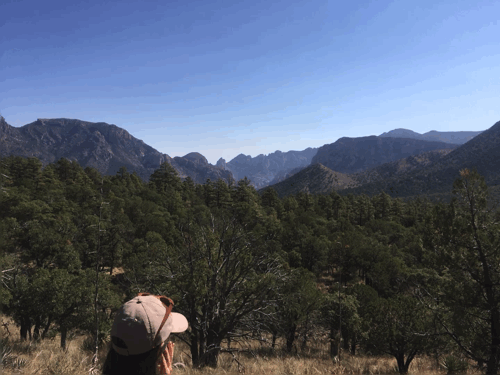Eared Quetzal Trip Report
You probably don’t need me to tell you that today (November 3rd, 2020) is Election Day. If you haven’t already, please go vote. If you have, it might be healthy to think about something else for a bit. To this end I offer a humble trip report from early October when Nell and I headed to southeast Arizona.
The primary target of our trip was a pair of famed Eared Quetzals that had been reported since June this summer. Nell and I were hesitant to chase these birds for months because they’re the kind of birds that draw crowds and, for some reason, we’re uncomfortable with crowds this year. However, the birds persisted through summer and fall, sometimes disappearing only to be re-found in nearby canyons. With the crowds thinning by early October we could almost hear the quetzals squealing to us. Finally, a series of coincident reports of other incredible birds came through the birding grapevine, coalescing into a perfect itinerary for a quick tour of southeast Arizona.
Java with the Jacana
We set off from Phoenix to Tucson with our food, water, camping gear and fresh coffee. Even before reaching Tucson, we had an appointment with a bird. Taking the Ina Road exit on the north edge of the city, we drove past hotels, gas stations, and expansive strip malls that define the sprawling American suburban experience until we got to where the road passes over the Santa Rita River. On the pedestrian path along the roaring four-lane bridge, we had a clear vantage point over the modest slow-flowing river. Truthfully there is nothing modest about any Arizona river with water. With dams, drought, and many sipping straws throughout the western watersheds there are only a few rivers defiantly flowing on. Looking down at the river, from just a stone's throw away, we had an unobstructed view of an adult Northern Jacana.
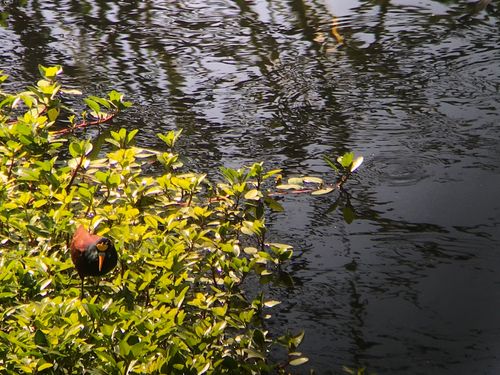
With extremely long toes, the Northern Jacana can walk on top of floating vegetation and pick off otherwise hard to reach aquatic insects. Rails and other marsh birds are usually notoriously hard to see, skulking quietly in inaccessible marsh reeds. This jacana, however, rarely found north of the border, was doing its thing in plain view from the bustling suburban pedestrian bridge. Our first "life bird" of the day.
Fizzy with the Phalarope, Reuben with the Ruff
After picking up some to-go sandwiches in Tucson, we continued our tour of Interstate 10. Next up was Cochise Lake in Wilcox, Arizona. As we scanned through hundreds of ducks, shorebirds, and a few dozen flyover Sandhill Cranes, we were visited by an uncharacteristically tame immature Greater Roadrunner. While the focus of our trip was skewed towards the rare and unusual, that doesn't mean we didn't savor some quality time with this prehistoric ground-dwelling desert cuckoo.
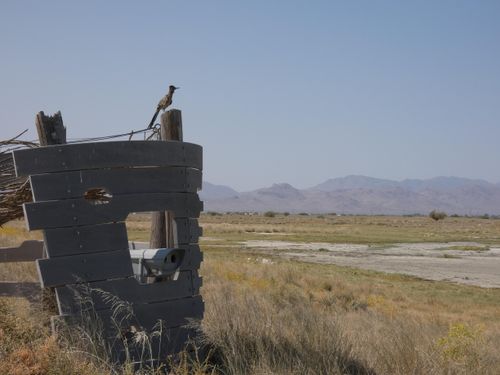
Returning to the search, we found one of our target birds: a type of phalarope, peculiar shorebirds whose females flaunt the flashier plumage and after laying their eggs leave the males to tend to the young. Very rarely seen away from the coast, our so-called Red Phalarope was in its nondescript non-red non-breeding plumage. Still cause for celebration, Nell and I cracked open a couple seltzers and continued to scan the lake.
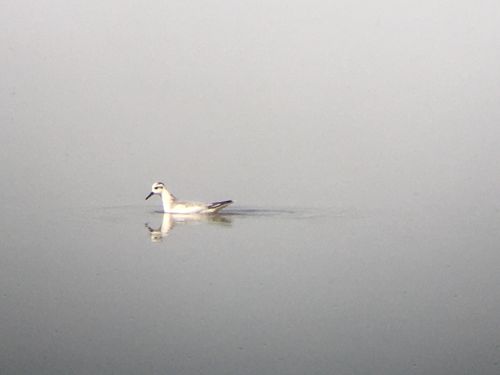
In the blazing direct sun (October is still hot here) with low blood sugar, we had a few confused misidentifications as we searched for another shorebird, briefly turning Greater Yellowlegs and Pectoral Sandpipers into the spectacularly out-of-place Eurasian species we were searching for. From across the lake, we caught a glimpse of a large shorebird with a relatively short bill and dull yellow legs with noticeably roughed-up scapulars and loose, floppy tertials. Driving to the other end of the lake we confirmed it was a Ruff, another shorebird with spectacular plumage while breeding in the arctic, sporting its drab non-breeding plumage for us. In celebration we found a patch of shade near the water and pulled out our sandwiches. Nell and I were very likely the first people in Arizona history to eat a reuben in the presence of a Ruff. Two more life birds for the day.
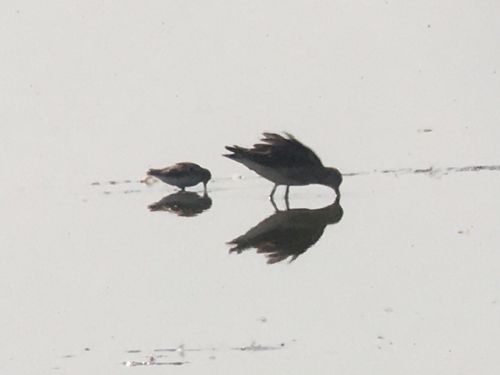
Coffee with the Quetzal
After another two-hour jaunt, venturing southward from the I-10 via dirt road, we arrived at Cave Creek Canyon in the Chiricahua Mountains, a nationally famous birding spot for turning up Mexican species that can be found nowhere else in the United States. The sun was setting but still we hoped to see the Eared Quetzals before we settled down to camp for the night. From previous reports we knew to park at the bridge along Forest Road 42 just down canyon from the Southwest Research Station. There were a couple parked cars but we didn’t see any other birders. We walked the road, stretching our legs, enjoying the quiet and cool canyon air, tall oaks and pines lining the road. Investigating some curious sounds coming from an apple tree along the road we found a dozen or so Red-naped Sapsuckers having a fruit feast, the most of this species either of us had ever seen in one place.
Momentarily distracted from our Quetzal quest, we then heard the distinctive squeal from about a quarter mile down canyon. We hurriedly shuffled down the road and spotted some movement through the trees. With each movement, there was a new announcement: “SqueeEEE-chuck”. From the other direction a few wide-eyed birders rounded the corner in pursuit and we all tried to catch glimpses of the visitors from the Sierra Madre Occidental. The birds were headed up canyon, presumably to roost for the night. We followed their sounds in the waning light, eventually catching a glimpse of one of the bird’s spectacularly blue back.
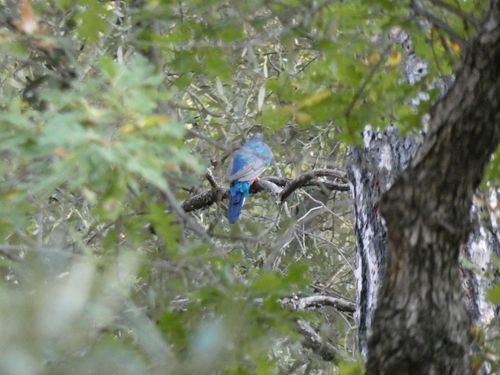
We hoped that this wouldn't be our only encounter with the quetzals, but still, hearing their squeals and seeing that shockingly blue back was already a highlight of the year. Elated and relieved, we could rest easy that night knowing we had experienced the Eared Quetzal, our fourth life bird of the day. Anything more was icing on the cake.
We headed to the John Hands Campground, a nondescript patch of flat ground next to the creek which was essentially abandoned when the forest service removed all basic campground amenities. We found it to be more than satisfactory, not least because we had it all to ourselves.
As dusk turned to night, we heard the tooting of (Mountain) Northern Pygmy-Owls, a Mexican subspecies whose song is slightly different than other Northern Pygmy-Owls. Listen for its uneven delivery of toots:
Later Whiskered Screech-Owls kicked off the next phase of the night with a burst of vocal activity, making a curious variety of sounds I had never heard before. I suspect it was a mix of adults and immatures judging from the varied quality of the calls but I’m not sure. Here is a phone recording from inside our tent to give an idea of how loud it was:
We also had some mammalian visitors in the night. Several times throughout the night we heard the rustling and sniffing of an apparently very curious critter just outside the tent. When we shot up and shined a headlamp towards the sound, our eyes were filled with the terrifying sight of a fluffy black and white skunk tail poised for action just feet away. Each time, thankfully, our friend the skunk would trot away without also filling our noses.
At dawn the next morning we brewed some coffee and headed back to the bridge on Forest Road 42. Sure enough the Eared Quetzals returned from their roost, this time foraging nonchalantly in trees overhanging the road much to the delight of the handful of birders present.
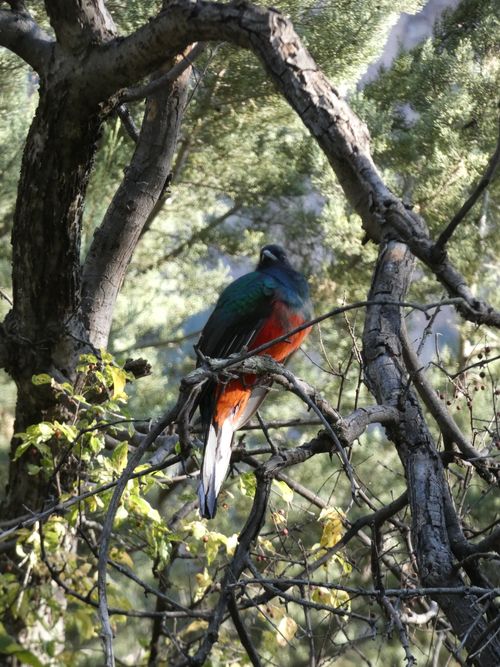
Just look at that freakin’ bird.
Each time they moved to a new perch they would chatter and squeal in the most delightful way. Just listen to this freakin’ bird:
Here is the female in all her glory:
Here is the male, exciting a giggle from the author:
More sounds and photos can be found on our eBird checklist here.
We spent a couple hours with the quetzals as they worked their way down canyon until they eventually flew to some inaccessible trees further from the road. Later, on our way out, with our windows rolled down, we could hear the quetzals still squealing in the distance. In these situations you just can't help but say: What a good bird!
We decided to hike a nearby trail before the long journey home. We got some beautiful views of Cave Creek Canyon, both of us smiling ear to ear appreciating the excellent birds we had seen and the adventure they inspired us to go on.
